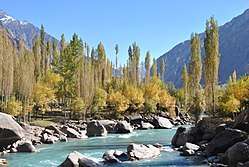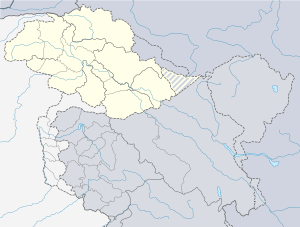Yasin Valley
Yasin (Urdu: یاسین Yāsīn), also known as Babaye-i-Yasen (بابائے یاسین) or Worshigum in the Khowar Language, (ورشیگوم Worśigūm), is a high mountain valley in the Hindu Kush mountains, in the northwestern Ghizer District in the territory of Gilgit-Baltistan, Pakistan.[1][2] The valley is about 148 kilometres (92 mi) from city of Gilgit (the capital of Gilgit Baltistan).[3] The Yasin Tehsil is situated on its territory.
| Princely state |
|---|
| Individual residencies |
|
| Agencies |
|
| Lists |

Yasin Valley, a lso Yasen in Khowar Language یاسین | |
|---|---|
 Yasin Valley, Ghizer | |
 Yasin Valley, a lso Yasen in Khowar Language Location in Pakistan  Yasin Valley, a lso Yasen in Khowar Language Yasin Valley, a lso Yasen in Khowar Language (Pakistan) | |
| Coordinates: 36°22′15″N 73°20′00″E | |
| Country | |
| Province | Gilgit Baltistan |
| District | Ghizer District |
| Time zone | UTC+5 (PST) |
History
Although sparsely populated, Yasin was of strategic importance because it leads to a high mountain pass, to Yarkhun in Chitral, and then to Broghil Pass in Chitral, the Wakhan Corridor of Afghanistan and into Tajikistan. Thus, Yasin could have formed an invasion route from Czarist Russia into British India.
Early period
Yasin was ruled by the Kho Rajas of Katur Dynasty, also known as the Mehtars of Chitral a collateral line of the Mughal sultans of Delhi, which came from Khorasan (Persia). The Rajas of Yasin were great warriors and fought against the Sikhs and the Dogras of Kashmir.
- c.1640 - c.1700 Shah Khuswaqt bin Mohammad Beg
- c.1700 Shah Alam
- c.1720 Shah Gahangir
- c.1740 Shah `Alamgir
- c.1750 Shah `Alam
- c.1760 Shah Badshah
- c.1780 - 1804 Mulk Aman (died 1804)
- 1804 - 1805 Kuwat Khan
- 1805 - 1828/29 Sulayman Shah (d. 1828/29)
- 1829 - 1830/40 Mir Aman
- 1841 - 1860 Ghauhar Aman (Gur Rahma) (born 1809 - d. 1860)
- 1860 - 1880 Ghulam Muhyiuddin
Chitral rule
Yasin was remained under the suzerainty of the Maharaja of Kashmir, then again ruled by the Mehtars (princely rulers) of Chitral.
Yasin Mehtars
- c.1892 - 1911 `Abd ar-Rahman Khan (1st time) (b. 1877 - d. 1948?)
- 1911 - 1912 Shahid al-Agham Khan (d. 1912)
- 1912 - 1922 Sifat Khan Bahadur (d. 1922)
- 1923 - 19. `Abd ar-Rahman Khan (2nd time) (s.a.).
People
The primary languages of Yasin Valley are Burushaski language and Khowar Language. Urdu is also widely understood.
The majority of the people in Yasin are Ismailis, who lead their lives according to the Islamic principles more concerned with the imam of the time. Currently Aga Khan IV is the imam and spiritual leader of the Ismailis. However, other branches of both as Sunni and Shia Islam also live in Yasin. Ethnically, the people of Yasin are of Burusho origin; however, there are some migrants from different parts of the country.
The people of Yasin are known for their honesty, hard work and bravery. Havaldar Lalak Jan Shaheed who was given the Pakistan Military's highest award Nishan-e-Haider for his bravery in Kargil War in 1999, belonged to Hundur in Yasin valley.
Geography
Yasin is separated from the Ishkoman Valley by a high mountain pass. To reach Yasin one must take the Karakoram Highway north from Islamabad, and then turn left to reach Gupis in Ghizar. After Gupis, one continues northwest to reach the Yasin Valley.
The part of the valley where Khowar is spoken is known in the Shina language as Arinah.[4]
Villages
Administratively, Yasin constitutes Yasin Tehsil, which is part of Ghizer District. It is further divided into four local councils: Yasin, Sultanabad, Silgan and Thoi.
- Yasin consists of the villages of Chiliharang, Damalgan, Gindai, Noh, Morka, Atkash, Bujayot, Manichi, Thodass and Nazbar Valley. Thodass is the headquarters of this union council.
- Sultanabad union council consists of the villages of Chumarkhan, Taus, Barkhachi, Sultanabad (Met, Huyelti), Ghojalti, Sandi, Dalsandi and Qorqolti Valley. Taus is the headquarters of this union council.
- Selgaan union council consists of the villages of Barandass, Barkolti, Chilpi, Sheghetan, Hundoor, Terchet, Umalsat and Darkut, which leads to the Pass to Boroghol. Hundoor is the headquarters of this union council.
- Thoi Valley union council consists of the villages of Ghaingchel, Ishkaibar, Karimabad, Dalkoi, Dapis, Shamsabad(Druch), Harp, Rahimabad, Kuno, Shot, Chiryat, Ishqamdass, Draskin, Nalti, Dass, Thelti, Ishqamghoro, Mahrakabun and Mushibarnala, which leads to Yarkhun Pass. Harp is the headquarters of this union council.
Passes
The Darkut Pass connects Yasin with Wakhan and Chitral, height 4,267 metres (13,999 ft), Buroghul pass connect Yasin with Brughol, height 3,798 metres (12,461 ft) while the Thoi Pass connects Yasin to Yarkhun Chitral, height 4,690 metres (15,390 ft). Assumber pass connects Yasin to Ishkoman. Darkot Pass is an historical pass which has been labelled as a restricted zone by the government of Pakistan. This pass used to be the shortest means of communication between the Oxus and Indus. Most tourism is along the Assumbur Pass to the Ishkoman Valley. one pass is from Darkot yasin to Thoi. Three passes from Nazbar yasin connect to Mastuj Chitral, height 5,009 metres (16,434 ft), one pass from Bujayote Nala to Bawoshter Ghizat Shamaran, one other pass from Khaimet bar to Chitral (sources Aina e Dardistan By Hidayat ullah Akhter, edited by Javed sajid Sultanabad Yasin).
References
- "Yasin Valley in Ghizer District". Pamirtimes.net. Retrieved 8 September 2018.
- "Yasin Valley, Ghizer District, Gilgit-Baltistan". www.merawatan.pk. Retrieved 8 September 2018.
- "Yasin Valley on map". Google Maps. Retrieved 15 September 2019.
- Grierson, George A. (1919). Linguistic Survey of India. Volume VIII , Part 2, Indo-Aryan family. North-western group. Specimens of the Dardic or Piśācha languages (including Kāshmiri). Calcutta: Office of the Superintendent of Government Printing, India. p. 133.




